
Cádiz at roof level. Photo © Karethe Linaae
‘What a difference a day makes’ sang Ella Fitzgerald, though when it comes to Cádiz, I would have to expand that to 30 years, as it was about three decades from my initial visit until I returned to the city. On my first time as a party-crazed teenager, I thought it was a terribly boring place full of old people. Yet, upon my return - 30 years later - I found it to be one of the most intriguing coastal cities in all of Spain!
Cádiz has attracted sea faring explorers for more than 3000 years. Today, most visitors still come by water. The port is a favoured stopover for cruise liners, whose passengers swarm onto the main street for an hour of power shopping before they hurry back to their departing ships.

Sunrise over Cádiz harbour with the Constitución bridge. Photo © Karethe Linaae
Thankfully, we are in no such rush. Cádiz is located only a couple of hours drive from our home in Ronda, so we can easily get there in the morning, enjoy a day of seafood feasting and ocean-side reconnoitring, and still be home by nightfall. However, to truly experience the city, one ought to stay the night, because twilight and daybreak are the most beautiful times to take in this historical gem.
TIMELESS SILHUETTE
Whether arriving by boat, car or train, the skyline of old Cádiz has remained almost unchanged since the 18th Century. There are no high rises or blocky hotels spoiling the view. Since this narrow isthmus sticking out into the Atlantic is virtually a sandbank, the ground cannot withstand further or taller development. Real estate developers might regret this, but for me, this is the saving grace of Cádiz.
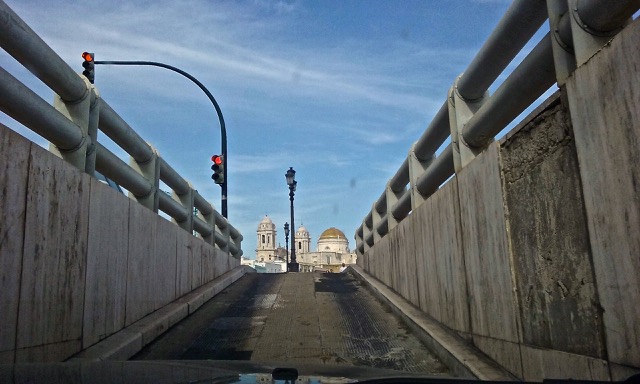
Leaving underground parking into 18. Century reality. Photo © Karethe Linaae
We arrive across the Constitution Bridge, which has connected Cádiz with the mainland since 2015. This impressive piece of engineering, taller than the Golden Gate, is one of Spain’s longest and highest sea-crossing overpasses. In contrast to its 1969 predecessor, the new bridge brings one almost directly to the historical centre, saving a detour through the less interesting parts of town.
Those who love the sea breeze can also get to Cádiz by ferry. From 1929, locals would take a steamboat nicknamed el vaporcito from Puerto de Santa Mária to town. Today high-speed catamarans have replaced ‘the little steamer’, but it is still a pleasant way to discover the Bay of Cádiz.
Upon arriving, our first mission is always to get rid of the car. The jumble of narrow lanes, dead ends and one-way streets in the historic centre make driving a trial and finding street parking as likely as winning the lotto. We therefore stop in the nearest parkade after having driven through the 16th Century defensive wall that marks the boundary of old Cádiz.
WATCHING FOR MERCHANT SHIPS AND PIRATES

Cádiz watchtowers by the harbour. Photo © Karethe Linaae
Once upon a time, Cádiz had 160 towers, from where watchmen would keep a lookout for incoming ships and naval attacks, while shipping merchants would await their precious imports from the New World. Communication between the towers and the ships was apparently done by flags, so that the destination and even the prices of the arriving cargo would be determined before the ships had anchored.
Today there are still 129 of these watchtowers. Torre Tavira, named after its original watchman Don Antonio Tavira, is one of the few towers that still can be visited. Located at the highest point of the city, it became Cádiz official watchtower in 1778. By climbing up to the roof terrace, one is rewarded with the finest views of the city and its oceanic surroundings, especially via the ancient invention, la camera obscura, a mirror system that allows 360-degree views in real time.
A lesser known, but no less intriguing tower is La Bella Escondida (The beautiful hidden one). The city’s only octagonal tower is said to be named after an enclosed Rapunzel-like maiden, or a nun whose wealthy parents wanted to see their daughter of the cloth. It was therefore not a watchtower, as much as a tower where someone was being watched. It can neither be visited, nor seen from street level, so the hidden maiden might have to remain one of Cádiz’ many mysteries.
FROM GADEIRA TO CÁDIZ IN 3000 YEARS
Before we walk on, let’s stop in one of the many picturesque squares and travel back in time.
Cádiz is so ancient that it’s birth lives in the land of mythology. According to Greek legend, Hercules founded the city and named it Gadeira. The muscular god with his two lions can still be seen in the city’s Coat of Arms. As far as recorded history goes, Cádiz is considered the oldest continuously inhabited city in Europe. With a strategic position between the Atlantic and the Mediterranean, this Iberian panhandle was fought over by Phoenicians, Mauritanians, Carthaginians, Romans, Visigoths, Berbers, Vikings, Arabs, English and Spanish Bourbon armies, just to mention a few.
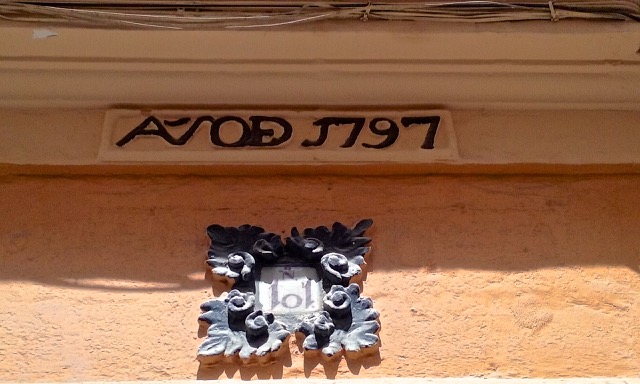
Anno 1797. Photo © Karethe Linaae
The first known settlers were Phoenicians from present day Lebanon, who arrived around 1104 BC. They named it Gadir (walled stronghold) and utilized the natural harbour to expand their European trade, importing Baltic timber, Basque silver, and British tin! (And we are talking 3000 years ago…)
Little more was known about the settlement until 2012, when a 19th Century puppet theatre was renovated. Nine meters below present-day street level one discovered 3100-year-old Phoenician streets, homes, and workshops. For those who wish to know more, the theatre has been converted into the astonishing glass floored GADIR museum.
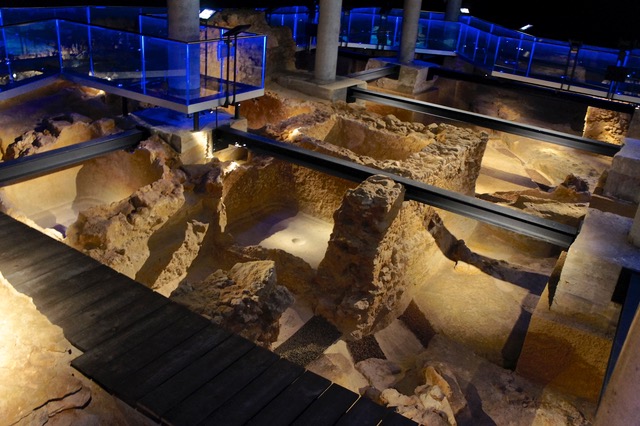
The floor in the Gadir museum with Phoenician streets. Photo © Karethe Linaae
In 206 BC, the Romans established a naval base in Cádiz, renaming the city Gādēs. Visigoths overthrew the Romans in 410 AD and a century later, Cádiz was incorporated into a Byzantine Spanish province. From 711 AD, it became part of the Moorish Al Andalus. They called the city Qādis, from which the Spanish name derives. The Moors lost their stronghold to the Spanish in 1262. Some 300 years later, Sir Francis Drake plundered the city, leaving with 3000 barrels of sherry. Many tried to take over the strategic port thereafter, but none succeeded, not even Napoleon!
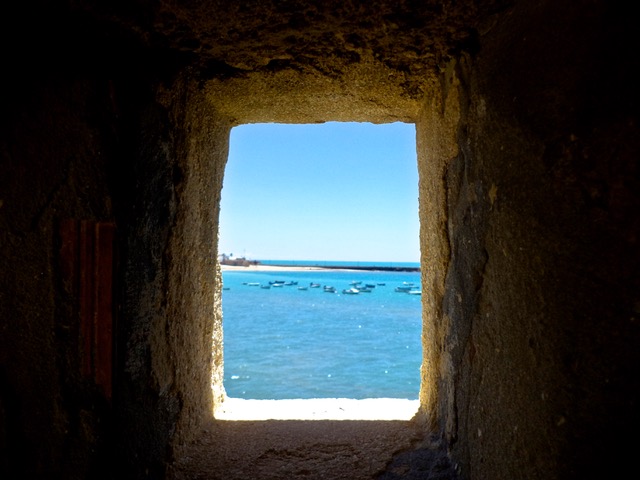
Peak hole. Photo © Karethe Linaae
COLUMBUS AND THE GOLDEN AGE OF CÁDIZ
In 1465, Cádiz was a sleepy fishing town with just over 1200 people. Then came Christóbal Colón, and everything changed. At dawn on September 25th, 1493, Christopher Columbus set off from Cádiz on his second voyage across the Atlantic. The city’s boom began with his ‘discovery’ of the Americas, which on that particular journey included Jamaica, Puerto Rico, Cuba and Santo Domingo. Cádiz was suddenly on everyone’s lips.
Outside the humble church of San Juan de Dios you find a plaque commemorating Columbus’s two transatlantic voyages that started in Cádiz. Though the church is one of the smallest in the city, and in dire need of renovation, some say that Columbus and his crew prayed here before taking off on their risky journeys.

Was this where Columbus prayed before setting off to Amerika? Photo © Karethe Linaae
It wasn’t until the 18th Century that Cádiz experienced its real Golden Age. Due to the constantly changing banks of the Guadalquivir River, the Spanish decided to move their American trade office from Seville to Cádiz. With newfound importance, the population grew from 40.000 to 80.000 inhabitants, not counting the 20.000 ‘floating’ residents. Cádiz became one of Europe’s wealthiest cities, as any merchandise that came or went to America had to pass through the city. It is still one of Spain’s leading ports, and its wealth continues to be based on the sea.
GADITANO STYLE
The exposed location of Cádiz might make it look a bit more weathered than other Andalusian towns, but this also adds character. The old city has that mystical allure of old ports - not exactly seedy, but a bit illicit, and thus all the more interesting. Maybe this is why meandering around in Cadiz has the same feel as being in Havana?

Havana? No, this is Cádiz! Photo © Karethe Linaae
The watchtowers are not the town’s only unique structures. The buildings in the historic centre have some unconventional design features, exclusive only to Cádiz. This Gaditano style has architectural influences from both sides of the Atlantic, as the city became a visual extension of its global trade. Cádiz was the closest Europe had to an American city. The people of Cádiz, the gaditanos, were described as having an international flair in how they spoke, dressed, ate, and worked. Even its public gardens were decorated with exotic plants and trees brought back from the New World, and some are still there!
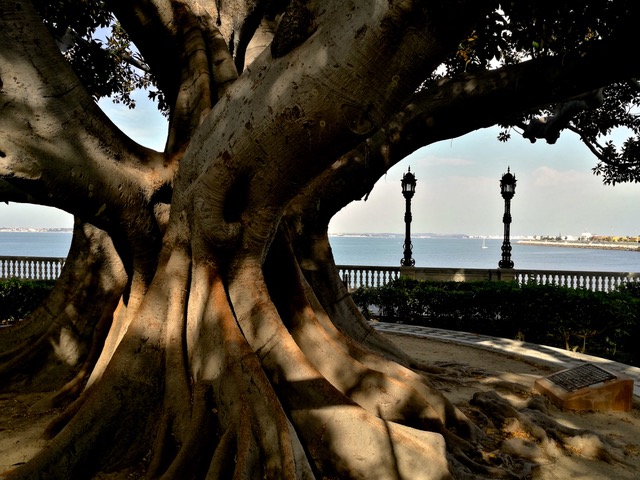
Fig tree. Photo © Karethe Linaae
One of the most unique things about the historic centre is that it is still very much a living urban community. Locals insist that true gaditanos must live in the old city, which to them is the only real Cádiz. With almost 127.000 people residing on a 5-square-kilometre strip of land, it is one of Europe’s most densely populated urban areas.

A Cádiz classic. Photo © Karethe Linaae
CATCH OF THE DAY
You simply cannot visit Cádiz without indulging in some of their local seafood specialties. Cádiz has always been known for its mariscos, which have begun to attract international foodies. One of the greatest joys of going to Cádiz is sitting in an unpretentious beachside joint with a plate of fried squid and a glass of dry Fino sherry. Or venture into one of the many local seafood restaurants, the best of which are generally found on side streets, or near the port. On cooler days, try the famous Cádiz fish stew, a recipe allegedly developed on trawlers as they returned to harbour, though I am sure many gaditanas had a hand in perfecting the dish.

Chipirones a la plancha. Photo © Karethe Linaae
El Mercado Central de Abastos from 1838 was Andalucía’s first covered public market. At the heaping counters, you can buy fish caught in the Atlantic at sunrise. The ‘catch of the day’ truly means del día. It cannot get any fresher. In the morning, locals swarm the market, undisturbed by gawking tourists, to purchase tuna, cuttlefish, octopus, mussels, eels, crabs, oysters, shrimps, razor clams, barnacles, and any ocean creature you can imagine. Then at night, the market converts into a local hangout, where you can go from stall to stall and order tapas, of course accompanied by a glass of wine or two.
EXPLORING A ROMAN NEIGHBOURHOOD
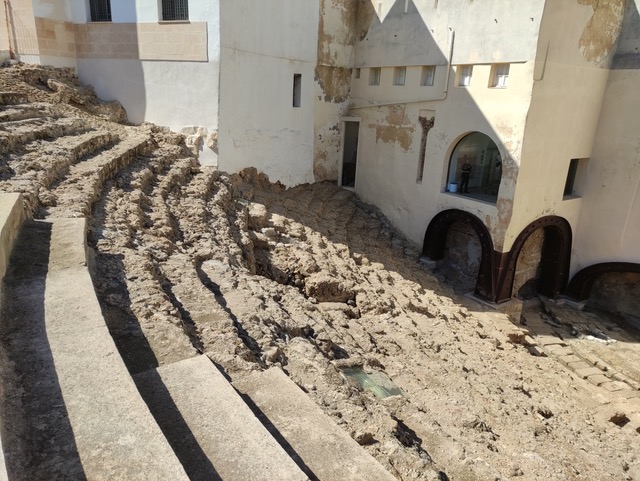
A 2000-year-old Roman theatre emerges out of a Medieval neighbourhood. Photo © Karethe Linaae
There are towns where it is a joy to get lost, and in Cádiz it is almost compulsory. The impossibly narrow cobblestoned streets and winding alleys make El Pópulo, a neighbourhood established by the Romans, a photographer’s heaven. You can sense the past grandeur of the old city, yet people still live in the historical homes where Cádiz’s affluent citizens resided in its Golden Era.

By Plaza de España. Photo © Karethe Linaae
Another curiosity as one wanders about, are the street corners. Since there were too many military weapons after the War of Independence, the extra cannons were embedded into street corners to protect against passing vehicles - then horse carriages, now cars and garbage trucks.

Narrow streets in the Casco histórico. Photo © Karethe Linaae
In the quaint and somewhat more modest working-class neighbourhoods La Viña and Santa María, one can observe the local gaditanos as they always have lived. Here the seafood is still sold right on the street from wheel carts or wooden boxes, and many shops seem unaltered since the early 1900s. In the former neighbourhood lies our favourite local bar, Casa Manteca. Even if you are not a manteca (lard) or pork lover, it is worth visiting this bullfight-themed tavern for its ambiance alone. Have a glass of Pedro Jimenez and watch the locals wolf down plate after plate of chicharrones.
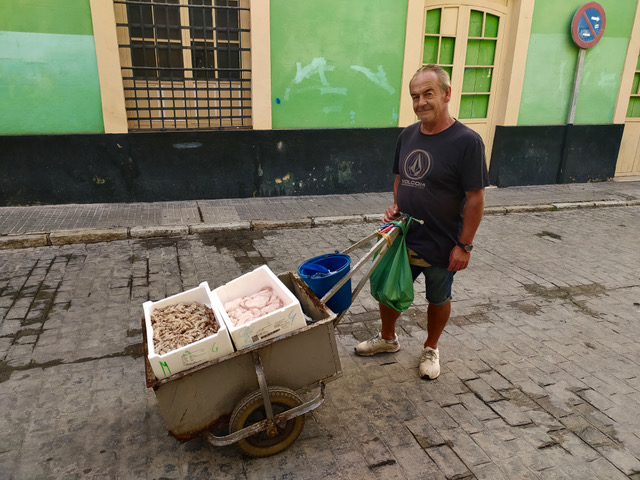
The catch of the day is still sold on the street. Photo © Karethe Linaae
Such ancient neighbourhoods are bound to hide some mysteries. One such secret came to light during a fire in 1980. Under the rubble, archaeologists discovered a Roman theatre dated from before the birth of Christ. Estimated to have been one of the largest and oldest in Spain, it housed 20.000 spectators. The structure was later used as the foundation for an Arab fort, as well as stables and houses in the Middle Ages.
The theatre has never been completely excavated since it lies beneath a protected medieval neighbourhood. In any case, the impressive semi-circular amphitheatre has free entry and is found only a couple of blocks from the cathedral square.
SUNSET MAGIC
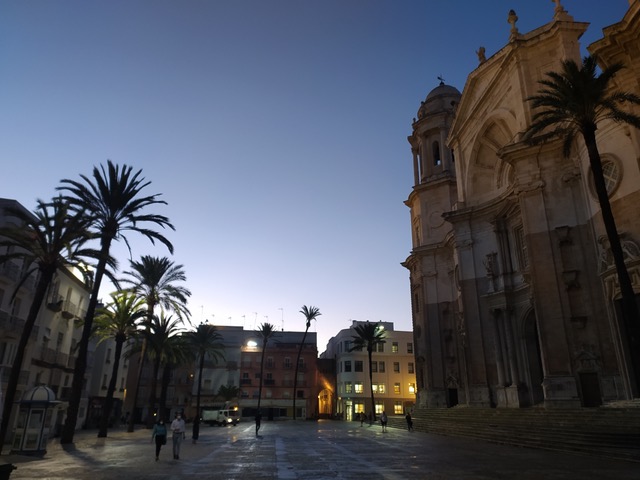
Cathedral square before sunrise. Photo © Karethe Linaae
At no time is Cádiz more striking than when the sun sets over the ocean and the city takes on a golden glow. This is when the locals take a leisurely paseo in the palm-lined Alameda de Apodaca Park, with its checkerboard flooring and flamboyantly tiled fountains and benches. The balmy Mediterranean climate allows for tropical flowers and some gargantuan fig trees, attracting all kinds of lovebirds…
Even if one spends the night bar-hopping, one should never miss a morning jolt around the seafront promenade following the entire parameter of the old city. The seawall with its giant boulders holding off the crashing Atlantic waves was apparently built to safeguard the city from English attacks in the 16th Century.
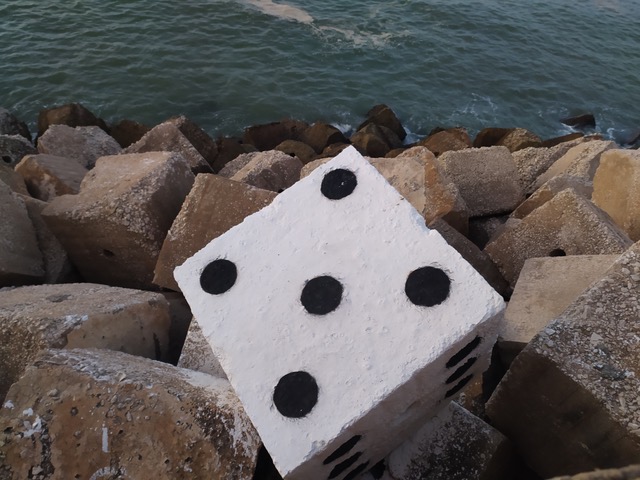
The boulders that hold back the Atlantic Ocean. Photo © Karethe Linaae
If you get up early enough, you might be lucky and have the entire Playa la Caleta to yourself. Unlike most Spanish beaches, it is refreshingly free from cocktail bars, banana boat rentals, massage huts, Balinese beds, and towering hotels. It still looks like an old post card, dotted with small brightly painted fishing boats. Located between two 16th Century defensive fortresses, it is a perfect place to take a morning dip.
We are not the first to ‘discover’ this beach, of course. A bikini-clad, yet armed, Halle Berry stepped out of the same waters in the 007 movie Die Another Day. Though the scene was set in Cuba, Cádiz’s similarity to Havana made it a perfect stand-in.
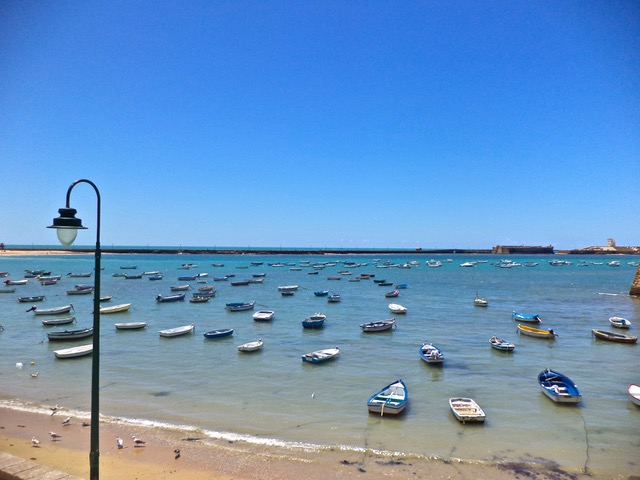
Colourful fishing boats by Playa la Caleta. Photo © Karethe Linaae
And here we leave the city with lightly windswept hair, salt on our skins, and the lingering taste of pescaito frito and Manzanilla, ready to come back soon to discover a few more of the town’s many secrets.
What a difference 30 years make, indeed…
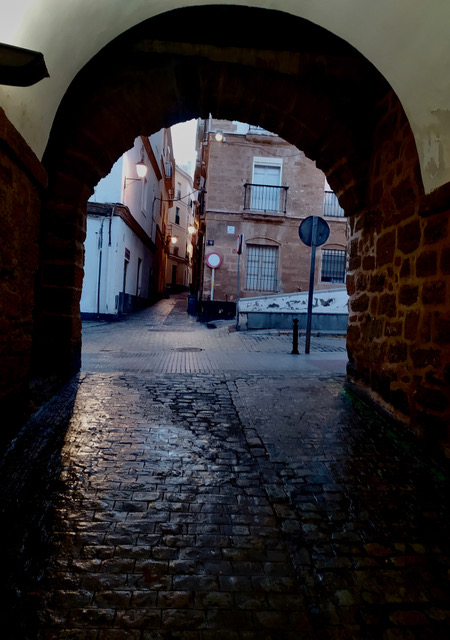
Alley. Photo © Karethe Linaae